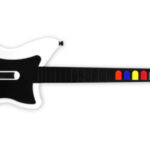Are you unknowingly damaging your guitar every time you change strings? Many guitarists, even experienced players, often string their guitars incorrectly, leading to potential damage over time. This common mistake, if left unaddressed, can result in costly repairs and shorten the lifespan of your beloved instrument. The good news is that stringing a guitar correctly is a simple process that, once mastered, will protect your guitar for years to come. This guide will walk you through the essential steps to ensure you are stringing your guitar the right way, safeguarding its structural integrity and maintaining its optimal performance.
Why Correct Guitar Stringing Matters
The key to proper guitar stringing lies in understanding the crucial role of the bridge plate. This piece of rosewood or maple, located inside your guitar beneath the bridge, is designed to withstand the pressure from the strings’ ball ends. Without the bridge plate, the tension of the strings would tear through the softer spruce top of your guitar.
Incorrect stringing techniques can severely damage this vital component. A common mistake is using the bridge pins to force the string ball ends into place and then pulling upwards to seat them. This action turns the string winding into a miniature saw, carving grooves into the bridge plate with each string change. Similarly, allowing the ball ends to sit perpendicular to the guitar body instead of parallel also concentrates pressure and wears away at the plate.
Over time, this repeated damage weakens the bridge plate holes. A telltale sign of a worn bridge plate is seeing the string windings protruding excessively through the bridge towards the saddle. Ignoring these signs can lead to significant structural issues, requiring expensive repairs that could easily be avoided with proper stringing technique. In fact, neglecting this can lead to bridge plate repair costs exceeding $100. However, by adopting the correct method from the outset, your bridge plate can remain in excellent condition for decades.
Step-by-Step Guide to Stringing Your Guitar Correctly
Follow these simple steps to string your guitar effectively and protect it from unnecessary wear and tear.
Preparing Your Guitar and Strings
Before you begin, gather the necessary tools:
- String Winder: This tool will significantly speed up the process of winding strings onto the tuning pegs.
- Wire Cutters: Essential for trimming excess string length after stringing.
- New Guitar Strings: Choose the appropriate gauge and type for your guitar.
- Optional: Small Mirror: A small mirror, like those from auto parts stores, can be helpful for inspecting the bridge plate inside the guitar.
- Optional: Bridge Pin Holder: Creating a simple block with marked holes can keep your bridge pins organized and in order, ensuring you replace them in their original positions.
Inserting the String Ball End Properly
This is the most critical step in preventing bridge plate damage:
-
Slightly Bend the String: Gently bend the ball end of the new string. This slight curve helps position the ball end correctly against the bridge plate. Avoid kinking the string; a gentle bend is sufficient.
-
Align and Insert: Insert the ball end into the bridge hole, ensuring it is aligned parallel with the guitar body. Push the ball end in until it is fully seated against the bridge plate. When correctly inserted, the ball end should curl towards the soundhole and become mostly hidden from view.
-
Hold and Secure: Maintain pressure on the ball end, holding it firmly against the bridge plate from inside the guitar. Now, insert the bridge pin to secure the string in place. It’s crucial to seat the ball end before applying tension to the string. Do not rely on the bridge pin to push the ball end into position.
-
Check Ball End Position: Before bringing the string to full tension, visually inspect that the ball end is seated correctly and parallel to the guitar body. Repeat this process for each string, one at a time.
Stringing at the Tuning Pegs
Once the ball ends are securely in the bridge, proceed to string the guitar at the headstock:
-
Measure String Length: To determine the correct length of string needed at the tuning peg, pull the string up to its corresponding tuner. Hold the string at the tuner post with your left hand. With your right hand, pinch the string at the 3rd fret and then move your pinch to the 5th fret, allowing slack to be pulled through your left hand. The point where your left hand is holding the string at the tuner post is where you should cut the string. This method provides the ideal length for proper winding around the tuning peg.
-
Cut the String: Using wire cutters, cut the string at the point you measured.
-
Wind the String: Insert the cut end of the string into the hole of the tuning peg. Use a string winder to turn the tuning peg, winding the string neatly around the post. Crucially, ensure that the string winds underneath itself on the tuning peg. This technique creates friction and prevents slippage, contributing to tuning stability.
-
Tune and Repeat: Tune the string to the correct pitch. Repeat steps 1-3 for each remaining string until your guitar is fully strung.
Conclusion
Mastering the correct way to string your guitar is a fundamental skill for every guitarist. By prioritizing the proper seating of the string ball ends and following these simple steps, you can prevent significant damage to your bridge plate and ensure the longevity of your instrument. Take the time to practice this technique, and you’ll not only protect your guitar from unnecessary wear but also contribute to maintaining its optimal sound and playability for decades to come. Consistent application of good stringing habits is a small investment that yields significant returns in the long-term health and performance of your guitar.

